Imagine stepping into a world where you can attend a business meeting, catch up with friends, or explore a new city—all without leaving your home. This is no longer a distant dream but a reality shaped by virtual reality technology. By 2025, the way we interact, communicate, and collaborate is set to transform dramatically.
From its early days as a tool for gaming and 360° videos, virtual reality has evolved into a powerful platform for social engagement. Companies like Facebook have pioneered platforms such as Horizon Workrooms, enabling users to connect in immersive environments. Similarly, Sandbox VR has redefined entertainment, blending physical and digital experiences seamlessly.
This shift isn’t just about technology; it’s about creating meaningful connections. Whether it’s for business, education, or leisure, social VR is becoming a cornerstone of modern communication. As we look ahead, the possibilities are endless, and the future of interaction is here.
Key Takeaways
- Virtual reality has evolved from gaming to a social communication tool.
- Platforms like Horizon Workrooms are leading the way in immersive experiences.
- Social VR enhances collaboration and interaction in various sectors.
- The future of VR focuses on accessibility and user engagement.
- Businesses are leveraging VR for training, meetings, and customer experiences.
Introduction to Social VR Trends in 2025
By 2025, virtual reality is reshaping how we connect, collaborate, and create. What began as a tool for gaming has evolved into a dynamic platform for social interaction. Today, VR is transforming industries, from business to entertainment, offering immersive experiences that bridge the gap between the physical and digital worlds.
The Evolution from Traditional VR
Traditional VR was once limited to simple, isolated experiences. Early adopters used it primarily for gaming or 360° videos. However, advancements in technology have paved the way for more complex, interactive environments. Platforms like Meta Horizon Workrooms now enable users to collaborate in fully immersive virtual spaces, redefining teamwork and communication.
This shift from passive to active engagement has been a game-changer. Users are no longer just observers; they are active participants in their digital environments. This evolution has opened new opportunities for industries like education, retail, and remote work, where collaboration and interaction are key.
Key Trends and Advancements Shaping the Future
Several trends are driving the future of social VR. First, hardware innovations are making devices more accessible and user-friendly. Lightweight headsets and improved motion tracking are enhancing the experience, making it easier for users to immerse themselves in virtual worlds.
Second, software advancements are creating richer, more interactive environments. Features like real-time avatars and spatial audio are making virtual interactions feel more natural. Companies like Multipost Digital are leading the charge, integrating these technologies into their platforms to boost user engagement.
“The future of VR lies in its ability to create meaningful connections, transforming how we interact and collaborate.”
Finally, the integration of VR with traditional media is reshaping entertainment. From virtual concerts to interactive movies, the line between digital and physical experiences is blurring. This trend is not just about entertainment; it’s about creating shared experiences that bring people together, no matter where they are in the world.
Emerging Technologies and Advances in Social VR
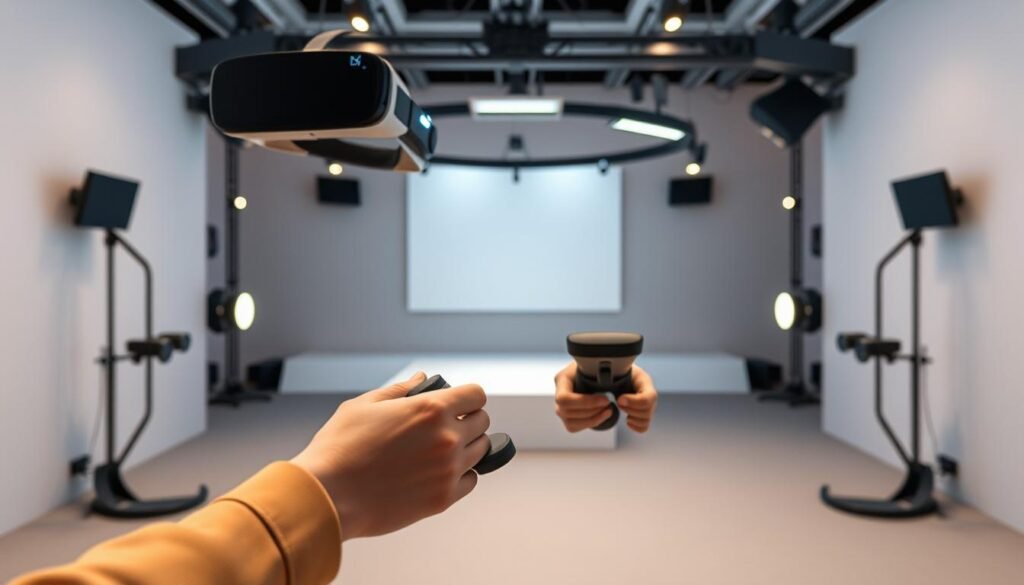
Cutting-edge technologies are reshaping how we interact and engage in virtual spaces. From hardware innovations to immersive platforms, the future of virtual reality is brighter than ever. These advancements are not just enhancing entertainment but also transforming industries like education, business, and healthcare.
Cutting-edge Hardware Developments
The latest hardware developments are making virtual reality more accessible and user-friendly. Devices like the Meta Quest 3 feature lightweight designs, improved motion tracking, and higher resolution displays. These innovations ensure a smoother and more immersive experience for users.
Advanced haptic feedback systems are also enhancing the sense of touch in virtual environments. This technology allows users to feel textures and interactions, making the virtual world feel more real. Companies like F1 Arcade are leveraging these advancements to create engaging simulations for both entertainment and training purposes.
Innovative Virtual Experiences Enhancing User Engagement
Software advancements are equally important in shaping the future of virtual reality. Platforms like Sandbox VR are creating rich, interactive environments where users can collaborate and socialise. Features like real-time avatars and spatial audio make virtual interactions feel natural and engaging.
These innovations are not limited to gaming. Businesses are using VR for remote collaboration, training, and customer engagement. For example, virtual property tours in real estate allow agents to showcase properties worldwide, breaking geographical barriers.
“The combination of hardware and software is revolutionising how we connect and interact in virtual spaces.”
As these technologies evolve, the line between the physical and digital worlds continues to blur. Whether it’s attending a virtual concert or exploring a new city, the possibilities are endless. To learn more about how VR is transforming social media, check out this insightful resource.
Rise of Social VR: A New Digital Paradigm
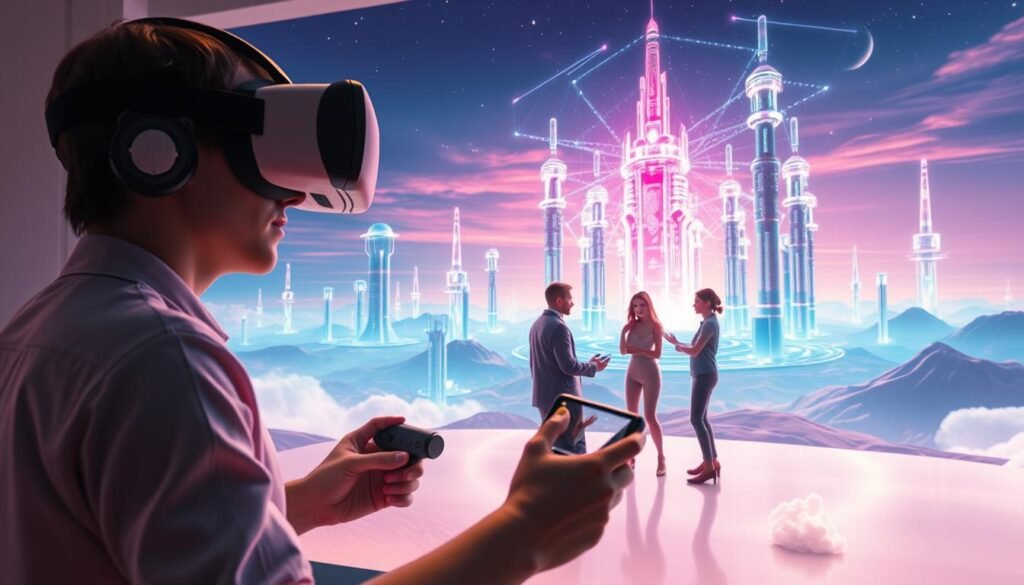
The digital landscape is undergoing a seismic shift, driven by immersive technologies. Virtual reality is at the forefront, transforming how we interact, collaborate, and engage with content. This new paradigm is not just about technology; it’s about redefining the way we experience the world.
In the early days, virtual reality was limited to simple games and simulations. Today, it has evolved into a dynamic platform for social interaction and collaboration. Platforms like Meta Horizon Workrooms and Sandbox VR are leading the charge, offering immersive experiences that blur the lines between the physical and digital worlds.
Organisations are leveraging this technology to enhance training, remote work, and customer engagement. For example, virtual property tours in real estate allow agents to showcase homes globally, breaking geographical boundaries. Similarly, businesses are using VR for team collaboration, creating virtual meeting spaces that feel as real as in-person interactions.
“The future of digital interaction lies in the seamless integration of virtual and physical experiences.”
Consumer habits are also changing. People are spending more time in virtual environments, whether for gaming, socialising, or exploring new content. This shift presents a unique opportunity for brands to connect with their audiences in innovative ways. From virtual concerts to interactive storytelling, the possibilities are endless.
As we look to the future, the challenge lies in making these technologies accessible to all. While high-end VR devices are becoming more affordable, there is still work to be done to ensure inclusivity. The next few years will see continued advancements, shaping a digital world that is more immersive, engaging, and inclusive than ever before.
Social VR Platforms Redefining Online Interaction
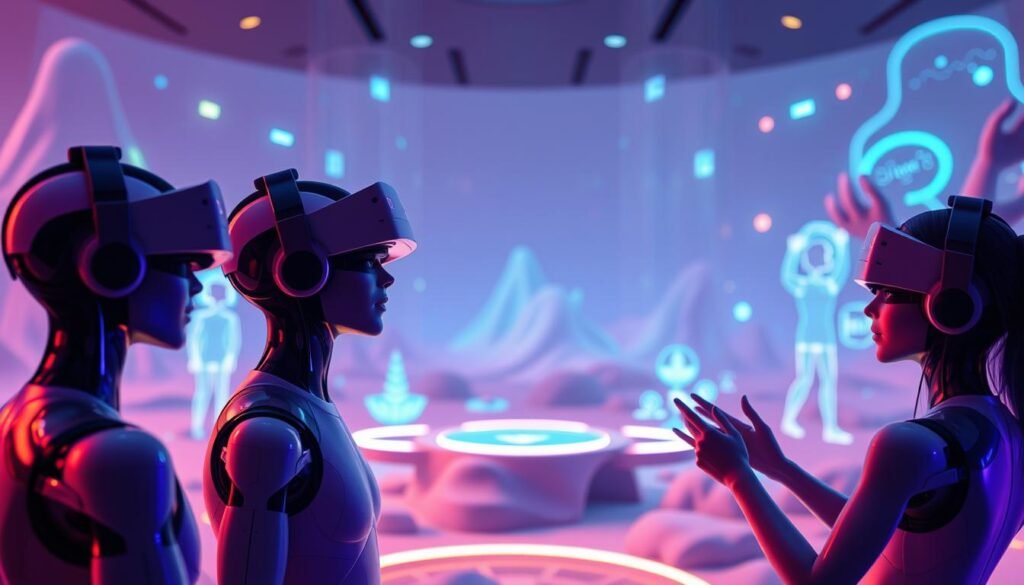
Step into a digital realm where boundaries fade, and connections thrive in ways never imagined. Social VR platforms are revolutionising how we interact online, creating immersive spaces that feel as real as the physical world. These platforms are not just about technology; they’re about fostering meaningful interaction and building vibrant communities.
Immersive Virtual Spaces and Environments
Platforms like VRChat and Meta’s Horizon Workrooms are leading the charge in creating immersive virtual spaces. These environments allow users to explore, socialise, and collaborate in ways that were once confined to science fiction. From virtual meeting rooms to interactive gaming worlds, the possibilities are endless.
These spaces are designed to feel natural and engaging. Features like real-time avatars and spatial audio make every interaction feel authentic. Whether you’re attending a virtual concert or exploring a new city, the experience is designed to captivate and connect.
Real-time Collaboration and Social Engagement
One of the most significant advancements in social VR is real-time collaboration. Platforms are enabling teams to work together seamlessly, regardless of their physical location. For example, Horizon Workrooms allows users to host meetings, brainstorm ideas, and even share documents in a fully immersive environment.
This technology is not limited to business. Educational institutions are using VR to create interactive learning environments, while healthcare providers are leveraging it for training and patient care. The result is a more connected and engaged community.
“The future of online interaction lies in the seamless blend of virtual and physical experiences.”
| Platform | Key Feature | Industry Impact |
|---|---|---|
| VRChat | User-generated content | Entertainment, Socialising |
| Horizon Workrooms | Real-time collaboration | Business, Education |
| Sandbox VR | Immersive gaming | Gaming, Team Building |
As these platforms evolve, they are redefining the concept of digital community. Users are no longer passive consumers; they are active participants in shaping their virtual worlds. This shift is creating new opportunities for engagement and collaboration across industries.
From virtual property tours in real estate to interactive storytelling in entertainment, the applications are vast. The future of online interaction is here, and it’s more immersive, engaging, and inclusive than ever before.
Integrating VR for Business, Training and Entertainment
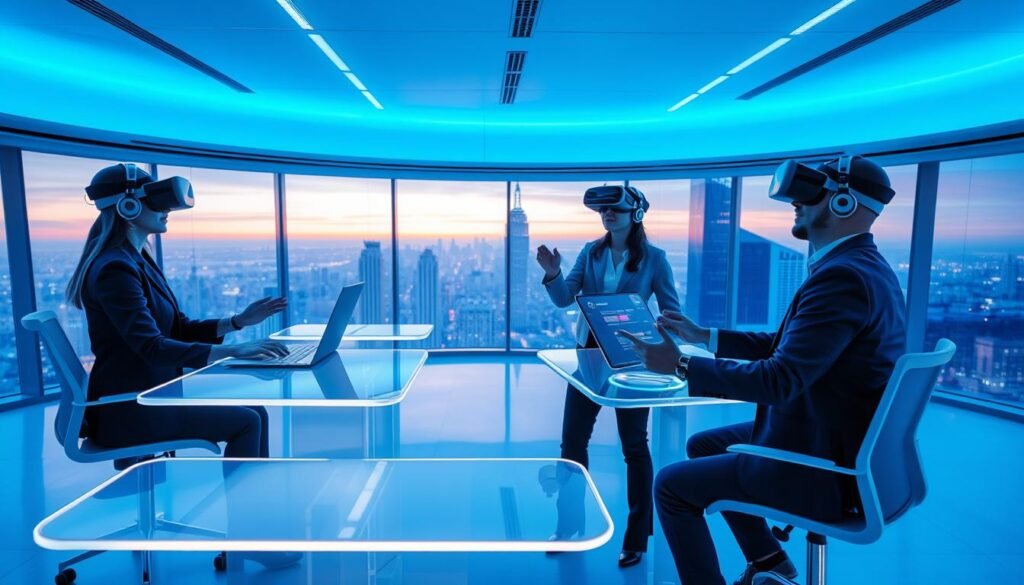
The integration of virtual reality into business, training, and entertainment is reshaping industries and creating new opportunities. From enhancing remote collaboration to providing immersive learning experiences, VR is proving to be a versatile tool for innovation.
Transformative Business Applications and Remote Collaboration
In the business world, VR is revolutionising how teams collaborate. Platforms like Horizon Workrooms allow users to host meetings in fully immersive environments. This technology eliminates geographical barriers, enabling seamless collaboration across global teams.
For example, architectural firms are using VR to create detailed 3D models of buildings. Clients can explore these designs in a virtual world, providing feedback in real-time. This approach not only saves time but also improves accuracy and client satisfaction.
Industry-Specific Training Solutions
In healthcare, VR is transforming training programmes. Medical students can practice surgeries in a risk-free simulation, honing their skills without endangering patients. Institutions like Stanford University are leading the way, using VR to train surgeons in complex procedures.
Similarly, the automotive industry is leveraging VR for design and safety testing. Engineers can simulate driving conditions, identifying potential issues before physical prototypes are built. This technology reduces costs and accelerates development timelines.
Entertainment and Engagement
Beyond practical applications, VR is enhancing entertainment experiences. Virtual concerts and interactive storytelling are redefining how audiences engage with content. Platforms like Sandbox VR are creating immersive gaming environments that blend physical and digital elements.
“The future of VR lies in its ability to merge practicality with creativity, offering solutions that are both functional and engaging.”
As VR continues to evolve, its impact on business, training, and entertainment will only grow. By embracing this technology, industries can unlock new levels of efficiency, engagement, and innovation.
The Impact on Immersive Content Creation and Advertising
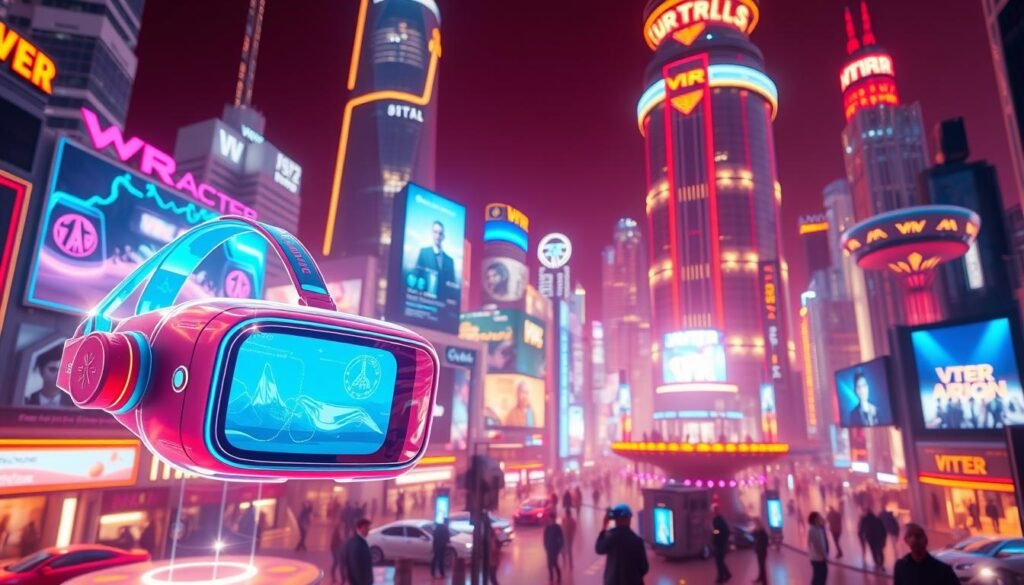
The advertising landscape is undergoing a profound transformation, driven by immersive technologies that redefine how brands connect with audiences. Virtual reality is at the forefront, offering new ways to create and deliver compelling content. This shift is not just about technology; it’s about crafting experiences that resonate deeply with users.
Evolving Creative Approaches for Engaging Campaigns
Brands are leveraging virtual reality to create immersive campaigns that captivate audiences. For example, companies like IKEA use VR to let customers visualise furniture in their homes before purchasing. This approach enhances engagement and builds trust with consumers.
Another innovative use of VR is in storytelling. Brands are creating interactive video experiences that allow users to explore narratives from different perspectives. This not only entertains but also strengthens the emotional connection between the brand and its audience.
“The future of advertising lies in its ability to create meaningful, immersive experiences that go beyond traditional media.”
Collaboration between creative and technical teams is key to these advancements. By combining storytelling with cutting-edge technology, brands can deliver campaigns that leave a lasting impact. This synergy is reshaping the industry, setting new standards for communication and engagement.
As VR continues to evolve, its role in advertising will only grow. From virtual product demonstrations to interactive brand experiences, the possibilities are endless. The challenge for brands is to harness this tool effectively, ensuring it enhances their message and connects with their audience on a deeper level.
Future Trends: AI, AR and the Metaverse in Virtual Reality
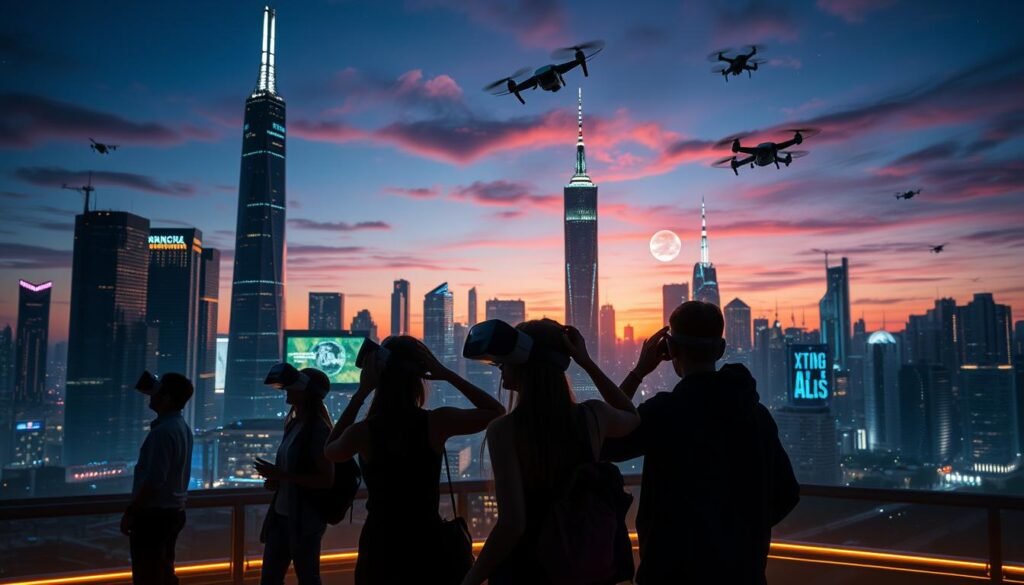
The convergence of AI, AR, and the metaverse is shaping a new era of immersive experiences. These technologies are not just enhancing virtual reality but redefining how we interact with the digital and physical world. By 2025, the lines between these realms will blur, creating seamless experiences that feel more natural and engaging.
Blurring the Boundaries Between Virtual and Real Worlds
One of the most significant trends is the integration of AI and AR into virtual reality. This combination allows users to interact with digital elements in their physical environment. For example, the Apple Vision Pro uses AR to overlay digital content onto the real world, creating a hybrid experience.
These advancements are not limited to consumer devices. Industries like healthcare and education are leveraging this technology to create immersive training programmes. Medical students can practice surgeries in a virtual world, while educators use AR to bring complex concepts to life.
Personalised, AI-Powered VR Experiences
AI is transforming virtual reality by enabling personalised experiences. Platforms now use AI to analyse user behaviour and adapt content in real-time. This ensures that every interaction feels tailored to the individual, enhancing engagement and satisfaction.
For instance, AI-driven avatars can mimic real-life expressions and gestures, making virtual interactions more authentic. This technology is also being used in marketing, where brands create personalised campaigns that resonate deeply with their audience.
“The future of virtual reality lies in its ability to merge AI, AR, and the metaverse, creating experiences that are both immersive and personalised.”
| Technology | Application | Impact |
|---|---|---|
| AI | Personalised avatars | Enhanced user engagement |
| AR | Hybrid experiences | Blurring virtual and real worlds |
| Metaverse | Global collaboration | Redefining social interaction |
As these technologies evolve, they will redefine how we connect, learn, and work. The future of virtual reality is not just about technology; it’s about creating meaningful interactions that enrich our lives. Businesses that embrace these trends will unlock new opportunities for collaboration and engagement.
Conclusion
Virtual reality has reshaped how we connect, work, and play. From immersive experiences to enhanced communication, this technology is transforming industries and daily life. Businesses now use VR for training and collaboration, while entertainment platforms create shared moments that feel real.
Emerging trends like AI and the metaverse are pushing boundaries further. These advancements promise personalised interactions and seamless integration between the digital and physical world. The future holds endless opportunities for growth and innovation in this space.
As VR evolves, it continues to bridge gaps and create meaningful connections. Whether for gaming, education, or business, it’s clear that this tool is here to stay. Stay informed about the latest developments to fully embrace its potential.
For more insights into how VR is shaping digital communication, explore this comprehensive resource.
FAQ
What is social VR and how does it differ from traditional VR?
What are the key trends shaping social VR in 2025?
How is social VR transforming online interaction?
What role does AI play in social VR experiences?
How are businesses leveraging social VR?
What impact does social VR have on content creation?
How does social VR integrate with the metaverse?
What challenges does social VR face in 2025?
Can social VR be used for entertainment?
Source Links
- What Is a VR Developer? Your 2025 Career Guide
- Top 8 Social Media Trends That Will Dominate In 2025
- The Future of Social Media: Virtual Reality, Augmented Reality, and Beyond
- The Metaverse Explained: How This Virtual World Is Shaping Our Future
- Virtual Reality Applications in the Real World
- Leveraging Emerging Technologies Like AI, VR And AR To Revolutionise Further And Higher Education
- Advertising in the Metaverse: A New Frontier for Brands
- How the Metaverse is Reshaping Virtual Worlds
- The many ways AI can empower XR | Computer Weekly
- Does Mindfulness Mediated by Virtual Reality Help People with Functional Diversity?
- LMS for Virtual Reality Learning: How VR Transforms Online Training
- Council Post: Meet The Metaverse: Practical Business And Social Applications
- Exploring the Applications of Virtual Reality in Medical Training
- Why Immersive Technology is a Key Prospect for Innovation – New York Weekly
- Augmented Reality Frameworks: Building Immersive Experiences
- The irresistible marriage of AI and XR | Computer Weekly
- Future of Advertising: Key Trends to Watch in 2025
- Comparing the effectiveness of virtual reality vs 2D display-based cue reactivity paradigms to induce nicotine-craving: a behavioral and psychophysiological study – Scientific Reports
- Can virtual reality reduce anxiety and pain in dental patients? – Evidence-Based Dentistry
- THE ROLE OF CYBER LAW IN VIRTUAL REALITY APPLICATIONS – Legal Vidhiya
